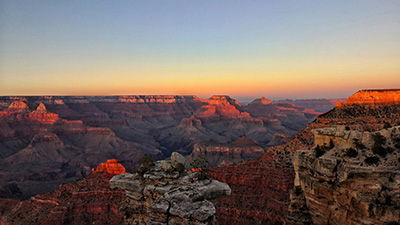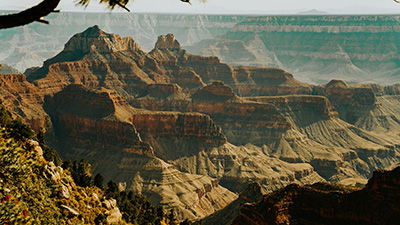
Large Gem Crystals Grew within Hours: Consistent with Rapid Granite Formation on a Young Earth
Because of the perception that the processes around us are always slow and gradual, most people think that the large crystals, for example, in their granite countertops, must have taken a long time to grow. That perception is reinforced by the pervasive indoctrination in our culture that such rocks take millions of years to form.
Crystal size is traditionally linked to the cooling rate of the magma (molten rock)1. Thus, lavas that erupt from volcanoes cool rapidly within minutes to days to form basalts, which consist of minute crystals mostly only visible under a microscope. In contrast, very large bodies of molten rock that cool and crystallize under the ground are thought to cool more slowly over 100,000-1 million years. The most well-known such rock is granite, with its visible crystals typically up to a centimeter or more (half an inch or so) in size.
Such timescales clash with the biblical timescale since the earth’s creation 6000-7000 years ago, and the global flood just over 4300 years ago when many granites formed from and within fossiliferous flood-deposited sediment layers. But do such large crystals take that long to grow?
The Pegmatite Puzzle
However, it should be noted that geologists have never actually observed the underground cooling and crystallization process.
These cooling and crystallization patterns seem straightforward – crystals take time to grow, so rapid cooling limits grain size, while slow cooling permits crystals to grow large. However, it should be noted that geologists have never actually observed the underground cooling and crystallization process. Furthermore, some field observations suggest that the above understanding of grain growth in nature is not so simple. For example, it is not uncommon to find granitic rocks with feldspar crystals known as megacrysts that are several centimeters to even 10 cm (4 inches) in size. Yet they are in large bodies (plutons) that cooled at shallow depths and thus presumably cooled faster than their finer-grained, deeper counterparts.2
More strikingly, decimeter to even meter-sized crystals (4 inches-3 feet) are typical of pegmatites, that compared to granite bodies are relatively small and thus likely cooled and crystallized quickly.3 Pegmatites occur as thick and long, vein-like bodies that often form associated with granites.
A lot of liquid water is dissolved in the magma from which granite forms. As the magma cools, the feldspar and quartz that crystallize to form granite do not soak up that water, nor most of the rare elements such as lithium and germanium that do not fit into those minerals’ lattices. The leftover magma becomes increasingly concentrated with water and rare elements, making the magma very fluid and easily squeezed into cracks in the surrounding rocks which are then forced open by pressure. In the cracks, the leftover watery magma crystallizes and cools very rapidly to produce the coarse-grained pegmatite.
So, water may play a crucial role in facilitating grain growth. In pegmatites, water is key to reducing melt viscosities and crystallization temperatures while enhancing melt transport, and thus allowing for much lower temperature crystallization to occur.4
But here is the puzzle. Pegmatites often contain some of the largest known crystals, but are seemingly short-lived cooling systems.
But here is the puzzle. Pegmatites often contain some of the largest known crystals, but are seemingly short-lived cooling systems.5 For example, the Etta pegmatite associated with the Harney Peak Granite of Mount Rushmore, near Rapid City, South Dakota, holds a world record for the largest single crystal, a spodumene crystal almost 13 meters (42 feet) long and weighing an estimated 33.5 tonnes (37 tons)! In other pegmatites the crystals are not so large but are routinely 10 cm (4 inches) or more long.
So, are these pegmatite crystals larger because they somehow had more time to grow, or do they represent rapid crystal growth that might result from more widespread suitable conditions than previously thought? Indeed, how could such large crystals grow from a rapidly-crystallizing, short-lived watery magma?
New Research
A recently-published study has upended previous thinking on the rate of crystal growth and demonstrated that the large crystals in some cooling magmas grow within minutes to hours.6 This includes mineral crystals in pegmatites that are gemstones, such as tourmaline and emerald.
The study focused on crystals in the Stewart pegmatite of the Pala district just north of San Diego, Southern California.7 This pegmatite, which is up to 50 meters (164 feet) wide, is mined for its quality tourmaline gemstones and valuable element minerals such as spodumene (a major source of lithium for cell phone batteries) that occur as large crystals up to10 centimeters (4 inches) long, and sometimes even longer.
Rice University, Houston, graduate student Patrick Phelps and geology Professor Cin-Ty Lee closely examined several smaller, zoned crystals of quartz (SiO2 or silica, the same as window glass), including one measuring 1/2 inch (12 mm) wide by over 1 inch (25 mm) long. These crystals came from “chimney”-like cavities branching upwards from the very coarse-grained core zone of the pegmatite body. Some of the largest of the exotic mineral crystals, including tourmaline crystals tens of centimeters (up to a foot or more) long, are located in these chimneys.
Their first investigative step was to use a cathodoluminescence (CL) microscope to obtain images of the quartz crystals to highlight their internal zoning. Then second, using a laser ablation inductively coupled plasma mass spectrometer (LA-ICP-MS) with a focused laser beam only 110 microns (0.0003 inch) wide, they obtained a series of closely-spaced spot analyses of trace elements in the quartz along several transects through the different zones in the crystals. By this procedure they demonstrated that the CL zones in the crystals were related to the zoned concentrations of trace elements such as lithium (Li), aluminum (Al), germanium (Ge), and titanium (Ti).
They argued that there are only two possible explanations for this trace element zoning – there were either changes in the fluid composition from which the quartz crystallized (external forcing), or changes in the nature and rate of crystal growth (internal processes).
They argued that there are only two possible explanations for this trace element zoning – there were either changes in the fluid composition from which the quartz crystallized (external forcing), or changes in the nature and rate of crystal growth (internal processes). The variations in extremely high Al concentrations between zones in these crystals ruled out the first possibility. Al atoms do not easily fit into the quartz crystal lattice due to having a different charge and thus different ability to connect to neighboring atoms.8 Under those circumstances the observed zoning would not only have required highly unusual fluid compositions, but very large and sudden changes in fluid composition. Therefore, they concluded that because both these conditions are highly improbable, that option can be excluded. So, they explored the possibility that the trace element compositions reflected kinetic effects, internal processes related to rapid crystal growth.
How Fast Did the Crystals Grow?
To determine the crystal growth rates, they considered two key variables – the likelihood of the trace elements Ge and Al being brought into the crystals from the host fluids (their partition coefficients), and how quickly each of these trace elements are brought into the crystals (their diffusivities).9 Unlike Al atoms, Ge atoms easily substitute into the quartz crystal lattice in place of Si atoms.10
Furthermore, the other key aspects contributing to the crystal growth rates would be the high concentrations of these trace elements in the watery leftover magma, plus the rapid turbulent flow of this watery leftover magma into the chimney-like cavities within the pegmatite. These leftover elements in the watery mixture are able to move around a lot faster, and chemical diffusion rates are faster in such fluids, which tend to flow more quickly.11 So, when crystals start forming, elements can get to them faster, which means they can grow faster.
Starting from these first principles, these investigators thus modeled the possible growth rates of these crystals based on the concentrations of these trace elements in the leftover watery magma from which these crystals grew. They then compared their models with their actual measurements of the Ge and Al concentrations in the crystal zones.
They therefore concluded that the cores in the quartz crystals they investigated would have grown in less than three hours, and the outer zones in less than four minutes!!
Thus, on the basis of this known chemistry and physics, and sound math, they derived growth rates of 10-100 mm (0.4-4 inches) per day for the cores of the crystals and 1-10 meters (3-33 feet) per day for the outer zones!! They therefore concluded that the cores in the quartz crystals they investigated would have grown in less than three hours, and the outer zones in less than four minutes!! Furthermore, the largest crystals found in pegmatites would thus have grown in just days!! And smaller gemstones such as tourmaline and emerald12 would also have grown in hours.
Rethinking Millions of Years
Phelps said, “I remember . . . saying, ‘Is this feasible? I do not think this is right. Because in my head I was still kind of thinking about a thousand-year time scale. And these numbers were meaning days or hours.”13
Such rapid growth rates of these pegmatite crystals may seem outrageous and extraordinary to these scientists with their slow-and-gradual mindset. However, independent studies have already demonstrated similar rapid growth rates were necessary to produce some large crystals in certain granites,14 and the large crystals found in some volcanic rocks.15 So, the growth of large crystals in minutes to within hours to days is well-demonstrated and well-known from experiments, whereas this study is significant for determining such fast growth rates for naturally grown crystals.
Can these results be also applied then to the growth of all the crystals in granites, thus necessitating the granites themselves formed within days? These investigators simply deferred to the evolutionary geology dogma that granite bodies take up to a million years to form, cool and crystallize. But yes, they did suggest it may be worth reconsidering whether large crystals in other magmatic systems, such as those in granites, are a consequence of rapid growth using this same research strategy.
Therefore, this evolutionary geology dogma emphatically does not disprove the biblical age of the earth of only 6000-7000 years and the global flood cataclysm that occurred about 4300 years ago. Indeed, there is much other evidence now available that demonstrates many granites, and their crystals, could have formed within days during the catastrophic global Genesis flood.16
Sadly, these scientists are willingly ignorant of (2 Peter 3: 3-6) and suppress (Romans 1: 18-20) so much evidence around the globe for the Genesis flood cataclysm.
Sadly, these scientists are willingly ignorant of (2 Peter 3: 3-6) and suppress (Romans 1: 18-20) so much evidence around the globe for the Genesis flood cataclysm.17 After all, its catastrophic watery conditions were unlike anything scientists have ever witnessed. So, blinded by their unbiblical evolutionary worldview they ignore the voluminous careful scientific research that continues to confirm what God’s inerrant Word teaches about the true history of the earth.
We must always remember that God never lies (Titus 1: 2). So, we can totally trust his Word as our absolute authority in everything, including His eyewitness record of the earth’s creation and history, in which his plan for our salvation unfolded.
Footnotes
- Helmut G.F. Winkler, “Crystallization of Basaltic Magma as Recorded by Variation of Crystal-Size in Dikes,” Mineralogical Magazine 28 (1949): 557–574; Geneviève Brandeis, Claude Jaupart, and Claude J. Allègre, “Nucleation, Crystal Growth and the Thermal Regime of Cooling Magmas,” Journal of Geophysical Research Solid Earth 89 (1984): 10161–10177; Katharine V. Cashman, “Relationship Between Plagioclase Crystallization and Cooling Rate in Basaltic Melts,” Contributions to Mineralogy and Petrology 113 (1993): 126–142.
- R.H. Vernon and S.R. Paterson, “How Late are K-Feldspar Megacrysts in Granites?” Lithos 104 (2008): 327–336.
- Bryan C. Chakoumakos and Gregory R. Lumpkin, “Pressure-Temperature Constraints on the Crystallization of the Harding Pegmatite, Taos County, New Mexico,” Canadian Mineralogist 28, no. 2 (1990): 287–298; Karen L. Webber, William B. Simmons, Alexander U. Falster, and Eugene E. Foord, “Cooling Rates and Crystallization Dynamics of Shallow Level Pegmatite-Aplite Dikes, San Diego County, California,” American Mineralogist 84 (1999): 708–717.
- Peter I. Nabelek, Alan G. Whittington, and Mona-Liza C. Sirbescu, “The Role of H2O in Rapid Emplacement and Crystallization of Granite Pegmatites: Resolving the Paradox of Large Crystals in Highly Undercooled Melts,” Contributions to Mineralogy and Petrology 160 (2010): 313–325.
- David London and George B. Morgan, VI, “The Pegmatite Puzzle,” Elements 8, no. 4 (2012): 263–268.
- Patrick R. Phelps, Cin-Ty A. Lee, and Douglas M. Morton, “Episodes of Fast Crystal Growth in Pegmatites,” Nature Communications 11 (2020): 4986
- Douglas M. Morton, J. Blue Sheppard, Fred K. Miller, Cin-Ty A. Lee, “Petrogenesis of the Cogenetic Stewart Pegmatite-Aplite, Pala, California: Regional Implications,” Lithosphere 11, no. 1 (2019): 91–128; R.H. Jahns and L.A. Wright, “Gem- and Lithium-Bearing Pegmatites of the Pala District, San Diego County, California (Special Report No. 7-A),” State of California, Department of Natural Resources, Division of Mines, June 1, 1951.
- W.P. Nash and H.R. Crecraft, “Partition Coefficients for Trace Elements in Silicic Magmas,” Geochimica et Cosmochimica Acta 49 (1985): 2309–2322.
- J.A. Burton, R.C. Prim, and W.P. Slichter, “The Distribution of Solute in Crystals Grown from the Melt. Part I. Theoretical,” Journal of Chemical Physics 21, no. 11 (1953): 1987–1991: and E. Bruce Watson and Thomas Müller, “Non-Equilibrium Isotopic and Elemental Fractionation during Diffusion-Controlled Crystal Growth under Static and Dynamic Conditions,” Chemical Geology 267 (2009): 111–124.
- R.D. Shannon, and C.T. Prewitt, “Revised Values of Effective Ionic Radii,” Acta Crystallographica Section B 26 (1970): 1046–1048; James W. E. Drewitt et al., “Structure of GeO2 Glass at Pressures up to 8.6 GPa,” Physical Review B 81 (2010): 14292; Detao He, Cin‐Ty A. Lee, Xun Yu, and Michael Farner, “Ge/Si Partitioning in Igneous Systems: Constraints from Laser Ablation ICP-MS Measurements on Natural Samples,” Geochemistry, Geophysics, Geosystems 20 (2019): 4472–4486.
- Harald Behrensa and Youxue Zhang, “Ar Diffusion in Hydrous Silicic Melts: Implications of Volatile Diffusion Mechanism and Fractionation,” Earth and Planetary Science Letters 192 (2001): 363–376; E. Bruce Watson, “Diffusion of Dissolved CO2 and Cl in Hydrous Silicic to Intermediate Magmas," Geochimica et Cosmochimica Acta 55, no. 7 (1991): 1897–1904.
- Andrew A. Snelling, “Emeralds—Treasures from Catastrophe” Answers 6, no. 4 (2011): 72–75.
- Jade Boyd, “Earth Grows Fine Gems in Minutes,” Rice University, October 6, 2020, http://news.rice.edu/2020/10/06/earth-grows-fine-gems-in-minutes-2/.
- S.E. Swanson, “Relation of Nucleation and Crystal-Growth Rate to the Development of Granitic Textures,” American Mineralogist 62 (1977): 966–978; Julin Zhang, and Cin-Ty A. Lee, “Disequilibrium Crystallization and Rapid Crystal Growth: A Case Study of Orbicular Granitoids of Magmatic Origin,” International Geology Review 62 (2020), https://doi.org/10.1080/00206814.2020.1734975.
- Guilherme A. R. Gualda et al., “Timescales of Quartz Crystallization and the longevity of the Bishop Giant Magma Body,” PLoS ONE 7 (2012): e37492; A.S. Pamukcu, M.S. Ghiorso, and G.A.R. Gualda, “High-Ti, Bright-CL Rims in Volcanic Quartz: A Result of Very Rapid Growth,” Contributions to Mineralogy and Petrology 171, no. 12 (2016): article 105.
- Andrew A. Snelling, “Catastrophic Granite Formation” Answers Research Journal 1 (2008): 11–26, https://answersingenesis.org/geology/catastrophism/catastrophic-granite-formation/
- Andrew A. Snelling, Earth’s Catastrophic Past: Geology, Creation and the Flood, (Green Forest, AR: Master Books, 2009).
Recommended Resources

Answers in Genesis is an apologetics ministry, dedicated to helping Christians defend their faith and proclaim the good news of Jesus Christ.
- Customer Service 800.778.3390
- Available Monday–Friday | 9 AM–5 PM ET
- © 2025 Answers in Genesis





